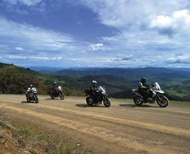
The big boys come out to play
WORDS: STUART “BIG BOY” WOODBURY PHOTOGRAPHY: NICK WOOD
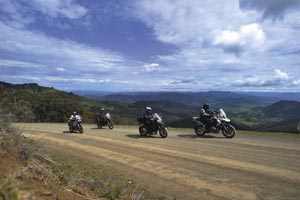





 Adventure. Let’s ponder that word for a minute; what does it really mean?
Adventure. Let’s ponder that word for a minute; what does it really mean?
Is it threading your way through heavy traffic on your daily commute? Getting away for a couple of days riding great roads? Or is it about discovering roads and trails you’ve never ridden before?
The Macquarie dictionary definition states: “1. an undertaking of uncertain outcome; a hazardous enterprise. 2. an exciting experience. 3. participation in exciting undertakings or enterprises: the spirit of adventure.”
It turned out that all three of those definitions would prove to be true.
Those who’ve become accustomed to the civilised world where everything is at their fingertips may have issues with adventure touring. Where should you go? What if you get lost? Will you die of thirst, be eaten by dingoes or get bitten by snakes? As well as those concerns, there are various items of civilised life that may not be available to you, like clean sheets, hot showers and edible food. If those things really upset you, you might as well stay home.
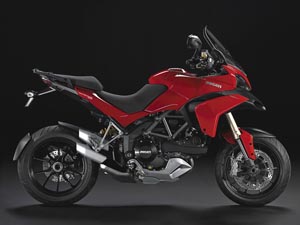
However, if you can cope with eight hours in the dirt, put up with wearing gunk-infested gear, drink warm water, eat deformed cereal bars and squashed sandwiches and at the end of the day crawl into a dusty sleeping bag — all without having a hissy fit — then adventure riding is for you.
That’s the extreme edge, but there are other ways to do it. For this two-day ride we stayed at the Roundabout Inn at Gloucester, which is modern, has great food and icy cold beer! Convinced yet?
The contenders
On our two-day ride from Sydney to Gloucester and back we pushed four of the bigger adventure-tourers to produce their best on just about every type of “road” you could imagine.
The bikes were the BMW R 1200 GS, the Ducati Multistrada 1200 S, the Yamaha XTZ1200 Super Ténéré and, just for a bit of variety, the BMW F 800 GS.
The current king of the adventure-bike world, the BMW R 1200 GS, braced itself to fight off the two new punks for its crown. Since the 1200 GS will do just about everything you ask of it, the challengers had one hell of a hard task in front of them. One of those challengers, the Ducati Multistrada 1200 S, is biased towards being a fast road bike but definitely does most things competently.
The other challenger is the Yamaha XTZ1200 Super Ténéré, the biggest machine in this group, and we’ve waited a long time for it to arrive here. To keep the bikes honest, we included a BMW F 800 GS, which is a hardcore adventure-tourer able to cope with all of the dirt roads and tracks that make up so much of our big brown land.
If there were pretenders, it didn’t seem that way: each bike looked as if it meant serious business.
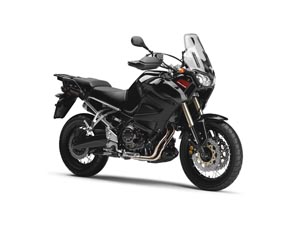
No-shows
Of course we wanted to include the KTM 990 Adventure, Honda XL1000 Varadero and Suzuki V-Strom 1000 but test bikes were not available. We did line up a Moto Guzzi Stelvio NTX but it was written off by a rider from another magazine.
(While on the subject of the NTX, when I did my original review back in ARR #62, I stupidly mentioned changing the rear sprocket. What is it about me and shaft drives? Must be from working on my father’s bike many years ago which was shaft driven and I hated it.)
However, it’s a real shame we couldn’t include the Guzzi to broaden the appeal for just about any type of adventure rider. Hopefully, we’ll be testing the other three soon.
The ride
It was a near picture perfect day when we set off and our route was the same as the exhausting one I took on my recent trip on the Yamaha 660 Ténéré. We knew these bikes would be a handful at times, but isn’t that all part of an adventure?
We acclimatised ourselves to them on some sweeping bitumen out to Wisemans Ferry and then to St Albans where the tight road immediately turns to dirt. We stopped at Bolwarra for lunch and to swap bikes. Then we saddled up and made our way to Dungog and the more challenging trails around Gloucester.
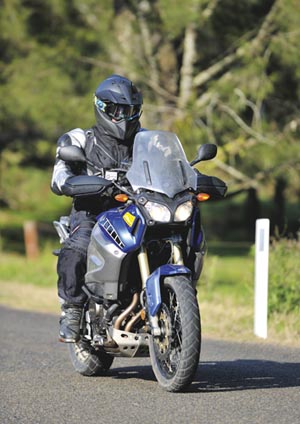
Pulling up for a photo shoot high up in the Watagan National Park midway through the morning, we looked out over Newcastle and out to sea. While savouring the view we had time to spin plenty of stories about our riding experiences so far. Nick took some fantastic shots of the four bikes against that breathtaking backdrop. Actually there were so many amazing sights on our two-day adventure that we’d probably still be there if we’d stopped to admire each one we saw.
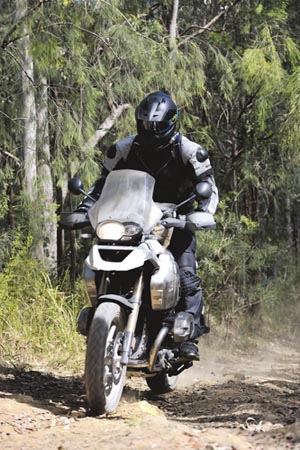
Most of the loose stuff we encountered on day one was relatively standard Aussie dirt with some pebbles thrown in now and then. We did find some harder rutted-out roads and all four bikes handled the conditions without complaint. It was only when we got to a really gnarly hill that we struck trouble and it was me on the Super Ténéré who came to a lurching halt as I let the revs drop too far. As I explain later, it was an issue we all felt with the Super Ténéré, which really needs to be revved hard to get it going.
Both the Super Ténéré and the BMW R 1200 GS have shaft drive.
Day two was another long day in the saddle. We started at sea level and rode up to 1700m in the Barrington Tops, from Gloucester to the Hunter region, down the infamous Putty Road and along the last stretch of dirt home.
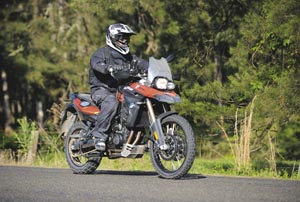
Handling
On bitumen, the Ducati Multistrada pushes the BMW R 1200 GS to its limits because it has super-trick electronic Öhlins shocks front and rear that are road biased. But it’s only on the extreme limits that you notice the difference between the two bikes. In fact, we all liked the easy-going nature of the 1200 GS which has electronic adjustable (Enduro ESA) suspension of its own.
The Yamaha Super Ténéré was a little outclassed on the road, mainly because it’s so big and it has slow steering geometry which makes the front feel lazy. Overall, the suspension is set up a little hard for the road and potholes made it jitter all over the place. I’m sure this could easily be fixed because both front and rear suspensions units are fully adjustable.
Even wearing knobbies, the light-steering BMW F 800 GS could be ridden competently and fast on the bitumen and it did do its job of keeping the big boys honest.
On the dirty stuff, the 800 GS smokes the lot of these bikes because it’s lighter and gives bucketloads of feedback to its rider. It was only when we got to some long, open stretches that the 1200 GS took over and was the bike I wanted. Phil, John and Nick still preferred the 800 GS, but I voted for the 1200 GS because it can be pushed to stay with the 800 in the tight stuff (it just requires a bit more effort), but roaring along with its tail wagging at pretty decent speed is so much fun it’s hard to describe!
Again, we were all bothered by the Super Ténéré which gave even less feel in the dirt than the road — the front had very little feedback, resulting in the occasional front slide that sent our hearts racing.
The 800 GS was wearing knobbies and the other three had dual-purpose adventure tyres of varying brands. We left tyre pressures at each manufacturer’s recommended psi; however, for more grip in the dirt you could set the pressures around 4-5psi lower, which will pick up a bit more grip while the tyres will still handle the bitumen OK.
Engines
The animal of the group is the Multistrada, particularly in Sport mode where it makes 110.3kW. This onslaught of power is a beautiful thing on any surface, but to get the most out of it in the dirt we switched to Enduro mode which cuts power to 73.5kW (still plenty for the dirt). The suspension was softened at the same time.
The 1200 GS pushes out 81kW and, thanks to the wide spread of power from its double overhead-cam engine, is the easiest bike to ride any way you want, on or off road.
The 800 GS has a fantastic engine that, just like its big brother, is so much fun to use, especially in the dirt. You can just wind it on and let it rev its head off or pull a higher gear and use its enormous torque to propel you along. We all loved riding the 800 GS and couldn’t wipe the big grins off our chops when we’d each finished our turn.
There’s 1200cc of big twin-cylinder engine shoehorned into the Super Ténéré frame but it proved to be lazy in most situations. On the dirt, the bike really needs to be revved hard to achieve its best. On the bitumen in sixth gear at speeds around 100–110km/h the twin lopes along with consummate ease and makes a perfect long-distance hauler and you can use all that torque to your advantage.
We’ve tested the other three bikes previously but hadn’t ridden the Super Ténéré before, so we thought we’d tell you a little more about its engine.
It’s an inline 1199cc twin cylinder with a 270-degree crank, four valves per cylinder with side-mount radiators. The engine layout is relatively slim and, because it’s fitted with Yamaha’s YCC-T ride-by-wire throttle, the rider inputs are precise and the 270-degree crank helps produce a good torque curve.
Brakes
Braking was a big talking point. Did we or didn’t we like ABS on the dirt? Nick preferred the ride with the ABS off whereas John, Phil and I found it useful on most occasions.
What’s more, I would love to see dual purpose bikes fitted with the system used on the BMW S 1000 RR superbike that allows the rider to have different ABS settings, including the ideal: front turned on and rear turned off. If this was available on any of these bikes you could ride much faster, with more confidence. ( It’s important to note that the ABS on the Super Ténéré cannot be switched off.)
Traction interaction
The other talking point about the 1200 GS, Multistrada and Super Ténéré was whether we liked the traction control on or off.
On bitumen, John, Phil and Nick preferred some traction interaction, I liked it switched off. For the dirt we all agreed traction control was too much of an interference and switched it off. The 800 GS doesn’t have traction control, so you don’t need to worry about it.
Fuel
One thing that did surprise us over the two days was how four very different bikes with different engine layouts and outputs, fuel tank capacities and different riders could prove to have such similar fuel consumption. The lightest bike, the 800 GS, got the best figures at 5.04L/100km. The heaviest bike, the Super Ténéré, used the most at 6.4L/100km. But when you work out that the Super Ténéré has the largest tank, in theory it gets about 40km more than the 800 GS.
Comfort
Naturally, comfort is one of the things most long-distance adventure riders want. The 800 GS loses out to the others because its seat is a little thinner and harder.
It was difficult to grade the Multistrada, 1200 GS and Super Ténéré because we had different opinions. John favoured the Multistrada, Nick the Super, and Phil and I voted for the 1200 GS.
The seat on the Multistrada is shaped well and padded in the right areas. Nick and I thought the Super Ténéré seat a touch too wide, but still very comfortable, and the 1200 GS is just great as it is.
Bits and pieces
Footpegs on the Super Ténéré, Multistrada and 1200 GS are good for the road and have rubber inserts which you can take out before those slippery water crossings. The 800 GS already has shark-tooth pegs for added grip.
We adjusted the bars forward on all four bikes so we could ride standing up more comfortably off road. While the others liked the setups, taller riders like myself would still find the bars on each bike a little low so, depending on your size and preference, you may or may not need to consider buying different bars or fitting risers.
The screens on the BMWs work excellently whether you’re sitting down or standing up. We found the Multistrada’s manually adjusted screen worked best in its lowest setting. The Super Ténéré was also best in its lowest setting, but you need a screwdriver to adjust it and it still buffeted my peaked helmet around at highway speeds.
All four bikes were fitted with 12V sockets. BMW has its own type of plug but the Ténéré and Multistrada use the generally available 12V (cigarette) plug. We fitted our Strike Motorcycle GPS to the Ténéré and it worked a treat without any issues, even through water.
In general, all dash layouts give all the information you could want; it’s just a matter of getting to know each bike’s idiosyncrasies to get the most out of the data available.
Although panniers and top boxes can be fitted to all four bikes we only had four tank bags and an Andy Strapz seat bag. When I told the boys to pack light I think we may have gone too light because the room available in the Wolfman, Giant Loop and BMW tank bags was astonishing, easily holding a weekend’s worth of gear.
So many accessories are available for all of them that we could fill an entire magazine if we listed the lot, but the Bear would kill me if I did it. Instead, check out each manufacturer’s website or ask your dealer for a pricelist (and don’t forget labour charges) to fit the bits.
Horses for courses
At the end of the two days we were enjoying cold beers while the engines cooled and reached some conclusions. To select the perfect adventurer, you need to choose the adventure you have in mind and then decide how adventurous your wallet is.
If it comes down to price, the 800 GS or Super Ténéré are the ones to go for. If you don’t care so much about the price, then it’s the 1200 GS (with the must-have Enduro ESA and traction pack) and the Multistrada that are likely to your heart aflutter.
If you want a more hardcore off-road adventure machine the 800 GS is the way to go. For a lazy adventure-tourer on bitumen, opt for the Super Ténéré. If you are a serious, fast bitumen hunter and will only ever ride on a dirt road to get to some other choice stretch of bitumen, the Multistrada 1200 S gets the gong.
Still, gratuitous foot-out cornering behaviour is mostly unnecessary.
But you want to know which bike we think is the absolute king of adventure — so bring another beer over here and I’ll tell you. Yes, it’s still the 1200 GS. This category was invented by BMW 30 years ago; they’ve been putting a lot of hard work into it ever since and it’s paid off.
If you want a motorcycle that will cope with anything you throw at it and still be at the pointy end of the bunch, choose the BMW R 1200 GS. The king has kept his crown. SW
SIDEBAR
Stuart’s Adventure Riding Hints
If you’re new to dirt riding and worried about sliding around or dropping your bike, I have some quick pointers for you:
* If you keep your bike upright and in line, even the heaviest machine will feel light. Lose that balance and the bike will suddenly feel heavy (obviously). The trick is catching it quickly and getting it back on track while moving or stopped.
* Stay loose and relaxed; use your body weight to make the bike do what you want it to do. If you’re tense and tight, you will come off sooner or later.
* Set up the hand and foot controls so that when you’re standing they are easy to use.
* Knobby tyres are the only way to go if you’re getting really serious and will be riding through mud, sand or on really rough trails. If you want to do a mix of on- and off-road riding, there are plenty of dual-purpose adventure tyres on the market.
* Most of all, slow down; it’s not a race. If you go too fast you won’t see rocks or fallen tree limbs and have time to react. Going too fast while learning will mean eating dirt and scratching that nice-looking bike.
Quickspecs
Model: BMW F 800 GS
Price: $17,250 (plus on-road charges)
Warranty: Two years, unlimited distance
Servicing km intervals: 1000km; every 10,000km thereafter
Engine: Liquid-cooled, 4 valve per cylinder DOHC, twin cylinder, 4-stroke
Displacement: 798cc
Compression: 12.0:1
Power: 63kW @ 7500rpm
Torque: 83Nm @ 5750rpm
Bore/stroke: 82×75.6mm
Transmission: Six-speed, wet multi-plate clutch, chain final drive
Suspension: Front, 45mm inverted fork, adjustable preload and rebound, travel 230mm. Rear, monoshock, adjustable preload and rebound, 215mm travel
Dimensions: Seat height 880mm, kerb weight 207kg (wet), fuel capacity 16 litres, wheelbase 1578mm
Tyres: Front, 90/90/R21. Rear, 150/70/R17
Frame: Tubular steel space frame, load-bearing engine
Brakes: Front, twin 300mm discs with dual-piston ABS calipers. Rear, 265mm disc, single-piston ABS caliper
Fuel consumption: 5.04 litres per 100km, premium unleaded
Theoretical range: 317km
Colours: 30 Year Edition; Lava Orange Metallic/Black Satin; Alpine White
Verdict: Let’s do it hardcore!
F800 BOX LABELS
1. A ready, willing and able 798cc liquid-cooled, 4 valve per cylinder DOHC, four-stroke twin is at your service.
2. Fully adjustable 45mm forks with 230mm of travel and fully adjustable rear monoshock with 215mm of travel signal the bike’s off-road capabilities.
3. Discs all round with ABS that can be turned off.
4. Serrated footpegs and high ground clearance will be your friends in the rough stuff.
5. At 207kg it’s light and agile and it was a blast to ride on or off road.
6. Choose from a zillion accessories, fit a GPS and the 800 GS will get you where you want to go.
Quickspecs
Model: Ducati Multistrada 1200 S
Price: $28,990 (plus on-road charges)
Warranty: Two years, unlimited distance
Servicing km intervals: 1000km, 12,000km, every 12,000km thereafter, (24,000km between major services)
Engine: Liquid-cooled, 4-valve per cylinder SOHC, Desmodromic L-twin, 4-stroke
Displacement: 1198.4cc
Compression: 11.5:1
Bore/stroke: 106×67.9mm
Power: 110.3kW @ 9250rpm
Torque: 118.7Nm @ 7500rpm
Transmission: Six-speed, wet multi-plate clutch, chain final drive
Suspension: Front, 48mm (Öhlins), inverted fork, adjustable preload, compression and rebound, travel 170mm. Rear, monoshock (Öhlins), adjustable preload, compression and rebound, 170mm travel
Dimensions: Seat height 850mm, kerb weight 189kg, fuel capacity 20 litres, wheelbase 1530mm
Tyres: Front, 120/70/ZR17. Rear, 190/55/ZR17
Frame: Tubular steel, Trellis frame
Brakes: Front, twin 320mm discs with four-piston monobloc ABS calipers. Rear, 245mm disc, twin-piston ABS caliper
Fuel consumption: 6.27 litres per 100km, premium unleaded
Theoretical range: 319km
Colours: Red; Black
Verdict: Truly four bikes in one
DUCATI MULTISTRADA BOX LABELS
1. You would quickly learn to throw yourself between the Ducati’s fabulous bodywork and the ground if you looked like falling over, but it’s proven itself off-road.
2. It’s a liquid-cooled, 4 valves per cylinder SOHC desmodromic L-twin four stroke with an insane power output that makes for road-riding ecstasy.
3. Fortunately, you can choose Enduro mode to make things more controllable off road.
4. Fully adjustable Öhlins front and rear offer 170mm of travel at both ends. Forks are beefy 48mm units.
5. It excels on the road, but don’t let the glamour trick you. It’s a true multipurpose bike.
6. Brakes are discs all round and ABS front and rear.
Quickspecs
Model: Yamaha XTZ1200 Super Ténéré
Price: $19,990 (plus on-road charges)
Warranty: Two years, unlimited distance
Servicing km intervals: 1000km; every 10,000km thereafter
Engine: Liquid-cooled, 4-stroke, DOHC, inline 2-cylinder, 4-valve, fuel injected, twin spark
Displacement: 1,199cc
Compression: 11.0:1
Power: 80.90kW @ 7250rpm
Torque: 114.1Nm @ 6000rpm
Bore/stroke: 98×79.5mm
Transmission: Six-speed, wet multi-plate clutch, shaft final drive
Suspension: Front, 43mm inverted fork, adjustable preload, compression and rebound, travel 190mm. Rear, monoshock, adjustable preload and rebound, 190mm travel
Dimensions: Seat height 845-870mm, kerb weight 261kg (wet), fuel capacity 23 litres, wheelbase 1540mm
Tyres: Front, 110/80/R19. Rear, 150/70/R17
Frame: Steel tube, backbone frame
Brakes: Front, twin 310mm discs with four piston ABS calipers. Rear, 282mm disc, single-piston ABS caliper
Fuel consumption: 6.40 litres per 100km, premium unleaded
Theoretical range: 359km
Colours: Yamaha blue
Verdict: Slow and steady can take the race
TÉNÉRÉ BOX LABELS
1. The liquid-cooled, 4-valve, DOHC, fuel-injected, ride-by-wire, inline twin puts out 80.90kW and 114.1Nm but you have to rev it to get the best from it off road. On road it’s a torquey, comfortable long-distance steed.
2. The Yamaha is a big, heavy bike with slow steering that would suit the more laidback adventure rider.
3. Fully adjustable suspension needs tuning because our bike came set up too hard for comfort and control on our dreadful, pock-marked roads. There was no feedback in the dirt either.
4. It’s got on/off traction control and ABS, on only.
5. Handguards are just some of the thoughtful off-road details fitted.
6. Don’t forget to take a screwdriver to adjust the screen. It works best on the low setting.
Quickspecs
Model: BMW R 1200 GS
Price: $21,925 (plus on-road charges)
Warranty: Two years, unlimited distance
Servicing intervals: 1000km; every 10,000km thereafter
Engine: Air/oil cooled, 4 valve per cylinder DOHC, 4-stroke, flat-twin cylinder
Displacement: 1170cc
Compression: 12.0:1
Power: 81kW @ 7750rpm
Torque: 120Nm @ 6000rpm
Bore/stroke: 101×73mm
Transmission: Six-speed, dry single-plate clutch, shaft final drive
Suspension: Front, 41mm BMW Telelever, adjustable preload, travel 190mm. Rear, BMW Paralever, adjustable preload and rebound, 200mm travel. Optional Enduro ESA available
Dimensions: Seat height 850-870mm, 820mm (low seat), 790mm (low suspension), kerb weight 229kg (wet), fuel capacity 20 litres, wheelbase 1507mm
Tyres: Front, 110/80/R19. Rear, 150/70/R17
Frame: Two-section frame with load bearing engine/gearbox unit
Brakes: Front, twin 305mm discs with four-piston fixed calipers. Rear, 265mm disc, twin-piston floating caliper. Optional ABS available
Fuel consumption: 5.42 litres per 100km, premium unleaded
Theoretical range: 369km
Colours: Alpine white; Magma red; Ostra grey metallic matt; Sapphire black metallic.
Verdict: Long live the king!
BMW R 1200 GS BOX LABELS
1. Super torquey 1170cc 4-valve, DOHC, 4-stroke flat-twin cylinder engine gobbles up both road and dirt.
2. Preload adjustable BMW Telelever up front gives 190mm of travel.
3. Fully adjustable BMW Paralever gives 200mm of travel. Pay for optional Enduro ESA electronic suspension adjustment — you’ll be glad you did.
4. Shaft final drive means no more cruddy chains to mess with.
5. If you don’t want to use ABS on the dirt, turn it off. We wish it had the BMW superbike’s system that allows you to keep the front on but turn the back off for sliding madness!
6. We turned the traction control off in the dirt.
7. For the average-sized rider it’s comfortable for a long day sitting down or standing up.
